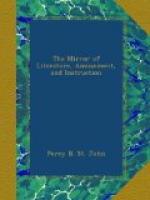We are bound to acknowledge our partial, if not entire concurrence, in the general criticism on the central front, and of the two wings. The first impression is far from that produced by unity, grandeur, or elegance; there is a fantastical assemblage of turrets, attics, and chimneys, and a poverty or disproportion, especially in “the temple-like forms” which complete the ends towards the park. The dome, too, has been sarcastically compared with a “Brobdignagian egg.” It strictly belongs to the back part of the palace, and had it been screened from the front, its form might have been less objectionable.
Of the internal arrangements of the palace, little is as yet perfectly known. On the principal floor of the centre, between the east and west suites of rooms, runs a splendid picture and statue gallery (the whole length of the building); the light into which is to be admitted from the sides, in a slanting direction, by metal skylights. The ceiling has iron girders thrown across, and is arched with combs, each having the ends closed, with the exception of a small hole (like an inverted flower-pot), which admits a current of air to circulate through the floor. The roof of this gallery is flat, and covered with slate embedded in a composition of hot coal-tar, lime, and sand: the roofing of the other parts of the palace is mostly covered with a similar composition, but not slated. The approach to the gallery is up the grand stairs, and through several rooms, in which will be disposed the king’s magnificent collection of armour. The floors throughout are fireproof, formed of iron joists, and arched with hollow bricks of a singular construction.
The group for the pediment of the east facade of the palace, representing the triumph of Britannia, by Mr. Bailey, is nearly finished.
The original gardens of Buckingham House, an extensive space, will of course continue to be the grounds of the new royal residence; but considerable alterations have been made to render them eligible for that purpose. In order to conceal from the windows the great pile of stables lately erected in Pimlico, near the lower end of Grosvenor-place, a large artificial mound has been raised, and planted with curious trees and shrubs.[1] The whole area now assumes all the appearances of natural hill and dale, is finely wooded, diversified with flowering and evergreen shrubs, with fine lawns broken into parterres, and possessing a noble serpentine piece of water, so disposed as to give the idea of great extent.[2] This water winds round clumps of forest trees, which have been preserved for that purpose, and all that could be retained of the previously existing scene. It is supplied from a large circular reservoir, (near the top of the hill at Hyde Park Corner,) which is fed by a main from the Serpentine river. This reservoir, almost like a Roman work for magnitude, may be made a beautiful feature in the gardens—in copious and refreshing fountains, but not in pools and ornamental basins, such as are included in the anathema of Dr. Macculloch.




